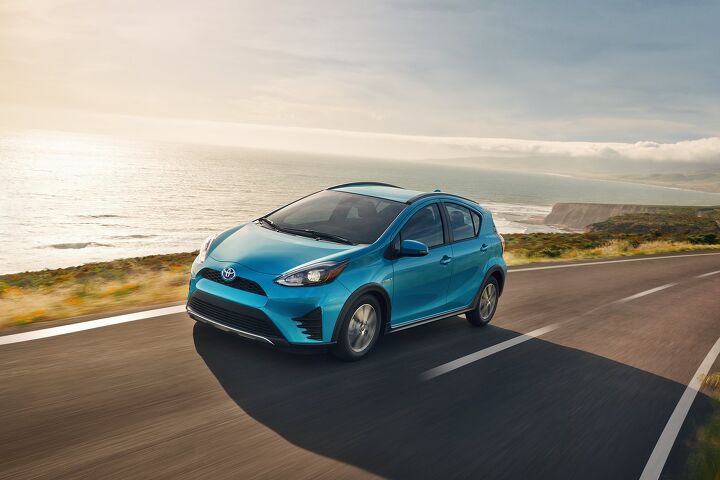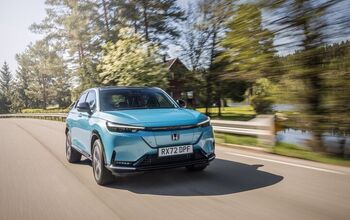Oh No They Didn't: Overnight, Toyota Turns 2018 Prius C Into a Land Cruiser Pretender
It started last year. Toyota, in concert with upgrading the Prius C with Toyota Safety Sense C added a matte black bodykit to the lower portions of the 2017 Prius C.
But for 2018, the Toyota Prius C is a veritable off-roader — a Rubicon-rolling, 4×4 river-fording FJ Cruiser successor.
The 2018 Prius C’s black cladding reaches up and around the wheel arches, and that cladding is interrupted at the Prius C’s chin by skidplate-aping metallic accents, heaven forfend.
Although the Toyota Prius C has migrated from the passenger car world to the trail-running SUV arena with nary a ride height increase and the same front-wheel-drive architecture, Toyota has managed to avoid fuel economy degradation. The 2018 Prius C is rated at 48 miles per gallon city, 43 highway, and 46 mpg combined, same as before.
More seriously, is crossoveresque styling enough to spur a measure of demand for the oft-rejected Prius C? Relatively uncommon upon its debut, U.S. Prius C sales peaked at 41,979 units in 2013, its first full year. But by 2016, sales were less than half that strong, plunging 47 percent from 2015 levels. Compared with last year’s poor performance, sales through the first half of 2017 tumbled a further 39 percent. Only 7,049 Prius Cs were sold in America during the first six months of 2017.
So far this year, the Prius C’s share of America’s subcompact market has fallen to 3.6 percent (from 4.8 percent a year ago) as Toyota generates the bulk of its subcompact sales with the Mazda 2-based Toyota Yaris iA. The Yaris iA and Yaris hatchback combine to outsell the Prius C by nearly four-to-one.
With no meaningful mechanical upgrades, the 2018 Toyota Prius C will still be the car that, according to Car And Driver, accelerates from 0-60 miles per hour in 10.9 seconds. Don’t expect to be thrilled, unless of course you leave the pavement and head up a mountain pass in the middle of a post-mudslide snowstorm.
The 2018 Toyota Prius C has a base price of $21,525, up almost $500 compared with the 2017 Toyota Prius C One.
[Images: Toyota]
Timothy Cain is a contributing analyst at The Truth About Cars and Autofocus.ca and the founder and former editor of GoodCarBadCar.net. Follow on Twitter @timcaincars.
More by Timothy Cain
Latest Car Reviews
Read moreLatest Product Reviews
Read moreRecent Comments
- Zerofoo Farley's blunder here is that the "Tesla and Apple people" are not a large enough market to support all the car companies that want to sell EVs. Chinese manufacturers alone could meet the demand of that market entirely without western companies at all.Farley's must accept that many people don't want an EV at ANY price. EVs, even with advanced battery chemistries, still require long charging times and when the battery is dead there is an unavoidable charging interval before you can get going again.Liquid fueled cars simply do not have these limitations, are readily available and affordable, and have vast aftermarket parts and maintenance support. This mix of convenience and support may never exist for EVs.If I could run my mobile phone and laptop on liquid fuels I probably would. Battery power, in many products, feels like a step backward.
- Theflyersfan I'm in the camp of that not all speed kills, but extreme speed differential kills. On a long drive, I can fall into a groove with long haul traffic going 75-80 in a 70 to 75 mph zone. No driving crazy or dangerous. What causes many wrecks in those situations are those going 50 in the left lane (way too common here), scared mergers entering at 40 mph, semis blocking multiple lanes, and unsafe drivers not using lights or driving unsafe cars. I also think the rise of 500 hp, 6,000 pound SUVs have dulled people into not realizing how quickly they are moving. It's almost like cruising at 38,000 feet if the SUV is comfortable. 85 mph in that is nothing until sudden braking or swerving is needed. Then Newton's laws take over. Compare that to a 2,300 lb MX-5 a few inches off of the ground. When you go 80, you know it. The engine and noise remind you! And you respect the speed a bit more.So I'm against speed limiters. I'm for much stronger enforcement and education and graduated licensing.
- Srd275 Enough of the nanny state
- 28-Cars-Later I realize it would be rewarding failure but could we force the legislatures and Congress critters to only work for six months out of the year to limit the damage and overall level of stupidity released?
- Dartman In the heads up display of my BMW it displays the speed limit of the road I’m on and if I exceed it it shows my current speed in red. Not obtrusive at all and useful. Not hard at all to ignore like on the freeway where the average speed is 75 but the limit is 65. Much ado about nothing . Speed limiters would be a different matter.



































Comments
Join the conversation
The reason for promoting black plastic cladding is that it looks like crap after a few years and so lowers the value of used cars.
Now folks will buy them and say they bought a hybrid CUV, blissfully unaware that they have a...wait for it...wait for it...hatchback! Watch for sales to climb! (said slightly tongue in cheek)